Volume 11 Number 2
©The Author(s) 2009
Interlimb Coordination: An Important Facet of Gross-Motor Ability
Abstract
Motor development attains landmark significance during early childhood. Although early childhood educators may be familiar with the gross-motor skill category, the subcategory of interlimb coordination needs greater attention than it typically receives from teachers of young children. Interlimb coordination primarily involves movements requiring sequential and simultaneous use of both sides of the body with a high degree of “rhythmicity.” This article provides a brief overview of the literature on interlimb coordination and describes the development of interlimb coordination in young children. It also provides examples of potential test items and activities that early childhood educators can use to help identify children with coordination problems and to help design a movement program for all children that addresses the development of interlimb coordination.
Introduction
Early childhood researchers and educators are well aware of the importance of promoting motor skill function in young children. In fact, early childhood is generally considered to be a period of landmark significance for motor development. Elements of “motor behavior that develop and emerge during this period provide a substantial part of the motor skill foundation upon which more complex motor programs are formed” (Gabbard, 2008, p. 280). Several studies also suggest that early motor behavior plays an important role in social, emotional, and later academic related activities (Wijnroks & van Veldhoven, 2003; Burns, O’Callaghan, McDonell, & Rogers, 2004; Murray, Veijola, Moilanen, Miettunen, Glahn, Cannon, Jones, & Isohani, 2006; Piek, Dawson, Smith, & Gasson, 2008).
In addition to aiding professional evaluations of overall physical well-being, assessment is important for early detection of children with a high risk for developmental disorders. Early detection enables practitioners to provide intervention at a young age, when plasticity of the nervous system is high. Early motor behavior plays an important role in a variety of life activities. For example, level of fine- and visual-motor ability is associated with daily-living skills (Jasmin, Couture, McKinley, Reid, Fombonne, & Gisel, 2009), movement proficiency (Astill, 2007; Wilson & McKenzie, 1998), and cognitive ability (Bumin & Kavak, 2008; Goyen & Lui, 2002; Piek et al., 2008; Wuang, Wang, Huang, & Su, 2008). Furthermore, recent research also indicates correlations between gross-motor skill and school (academic) performance (Astill, 2007; Gibbs, Appleton, & Appleton, 2007; Piek et al., 2008). Diamond (2000) suggests that both motor and cognitive performance share a common brain structure. Piek et al. (2008) noted that children who have better gross motor skills may be able to process information better and faster, which helps cognitive performance. In summary, there are several indications that early movement experiences are an essential agent for developmental change in children, including cognitive development (Campos, Anderson, Barbu-Roth, Hubbard, Hertenstein, & Witherington, 2000).
Of the general classifications of motor categories typically described (fine motor, visual motor, and gross motor), an aspect of motor function that has gained the attention of researchers in recent years is interlimb coordination. There are indications that this aspect of motor behavior differentiates academic performance in some populations of young children (Bobbio, Gabbard, Gonçalves, Barros Filho, & Morcillo, in press). Our intent with this article is to (1) describe interlimb coordination and its development, (2) provide examples of test items and activities, and (3) give recommendations for early childhood educators who work with young children.
Types of Interlimb Coordination
Interlimb coordination primarily involves movements requiring sequential and simultaneous use of both sides of the body with a high degree of “rhythmicity.” More precisely, it involves the timing of motor cycles of the limbs in relation to one another (Swinnen & Carson, 2002). Such actions are commonly divided into two categories: bimanual coordination and coordination of hands/feet.
Bimanual Coordination
This movement involves skilled interlimb coordination of the two arms in a bimanual action. Bimanual movements require intralimb coordination, as well as integration and sequencing of actions between limbs (i.e., interlimb coordination). Bimanual coordination represents a complex self-organizing system that is subject to both internal (biopsychological) and contextual (task) constraints. It has been suggested that development of interhemispheric transfer (Cardoso de Oliveira, 2002; Fagard, Hardy-Léger, Kervella, & Marks, 2001) and the corpus callosum play an important role in this process (Kennerley, Diedrichsen, Hazeltine, Semjen, & Ivry, 2002; Muetzel, Collins, Mueller, Schiessel, Lim, & Luciana, 2008). The corpus callosum is a structure of the brain in the longitudinal fissure that connects the left and right sides of the brain. Its main function is to facilitate communication between the two hemispheres—a process that is essential to interlimb coordination. Brakke, Fragaszy, Simpson, Hoy, and Cummins-Sebree (2007), who studied infants, note that bimanual coordination is clearly important to adaptive human functioning, yet our understanding of its development during childhood is incomplete.
Although several types of bimanual actions can be observed in an individual's repertoire, most research task items have focused on the patterns of coordination that appear in cyclic movements: for example, continuous finger tapping with index fingers of both hands, finger tapping with one hand while tracing a circle with the other hand, or circle drawing with both hands. Studies using such tasks indicate that there is evidence for interlimb control between the two hands beginning around age 4. Overall, several significant developmental changes occur between the ages of 4 and 10 years (e.g., Fagard et al., 2001; Otte & van Mier, 2006; Pellegrini, Andrade, & Teixeira, 2004; Robertson, Bacher, & Huntington, 2001). According to Brakke and colleagues (2007), children are more variable in timing many of their bimanual movements than are adults. For example, response times from one sequence or cycle of action to the next may not be stable. In that study, children were asked to draw two circles with both hands at the same time. The children were not as fast and as stable as the adults performing the same task; in other words, one of the child’s hands would lead the other during the task. Children also tend to move at a slower pace when performing repetitive actions, such as finger tapping or circle drawing, compared with adults (Fagard et al., 2001).
Hands/Feet Coordination
This type of interlimb coordination involves the simultaneous coupling (coordination) of the upper and lower limbs. Such actions are performed with upper and lower limbs on the ipsilateral (same) side of the body, or with contralateral movements involving the coordination of limbs on both sides. In general, rhythmic coordination of non-homologous limbs (e.g., hand and foot) is even more difficult to perform than bimanual movements because of mechanical differences between the limbs.
Typical tasks of hands/feet coordination include clapping while walking and tapping hand and foot to a selected rhythm. Assessment frequently involves observing the child’s ability to synchronize limbs with a rhythmic beat. Mackenzie, Getchell, Deutsch, Wilms-Floet, Clark, & Whitall (2008) note that with children who have difficulty, such as those with Developmental Coordination Disorder, it is not clear whether the problem is caused by a fundamental inability to coordinate the limbs together (without external cues) or by the failure to couple the external cues (assigned rhythmic beat) to motor responses with a consequent effect on limb coordination.
As seems to be the case with the development of bimanual coordination, studies show a period of significant improvement over the age range of 4 to 10 years in the coordination of hands/feet (Cavallari, Cerri, & Baldissera, 2001; Getchell, 2006; Getchell & Whitall, 2003). However, as a general observation, hands/feet coordination in children is more difficult than bimanual actions (Cavallari et al., 2001; Swinnen & Carson, 2002). For example, clapping hands is easier for young children than clapping hands while walking.
Examples of Activities
Unfortunately, few assessment batteries identify test items specific to interlimb coordination. Tables 1 and 2 provide examples, modified from commonly used activities and newly created items based on our personal experience as practitioners. Educators may wish to keep in mind that when evaluating behavior, focus is on rhythmicity of movements (e.g., timing and smoothness of transitions) and the ability to synchronize limbs. In other words, limb movements flow naturally in a cycle continuously. A movement marked by lack of interlimb coordination would not flow; for example, one limb would perform a movement then stop, followed by the movement of the other limb.
| Bimanual | What to Look For |
|---|---|
| Clap hands in time to a metronome (10 sec.). | Is the child able to keep the metronome beat? Clapping style is not analyzed. |
| Rhythmic flexion-extension movements of index fingers (10 sec.). | Does the child maintain synchrony of moving both fingers? |
| Draw circles with both hands simultaneously (10 sec.). | Same. And, are the circles recognizable? |
| Reciprocal finger tapping with both hands (10 sec.). | Is the child able to keep the tapping rhythm? |
| Catching ball with two hands (5 trials). | Does the child catch the ball in a smooth manner by timing the catch with two hands? |
| Tapping with one finger while tracing a circle or square with the other hand (30 sec.). | Is the child able to maintain the tapping rhythm and trace a circle in a synchronized manner? Observe the shape of the form as well. |
| Alternating opening and closing hands (10 sec.). | Can the child alternate movement in a synchronized manner? |
 With palms facing out and arms extended, move hands forward and back simultaneously (10 sec.). With palms facing out and arms extended, move hands forward and back simultaneously (10 sec.). |
Are the hands actions performed in a synchronized manner? |
Pivoting thumb and index finger—touch the tip of the right index finger to the tip of left thumb, then pivot the hands to touch the tip of the left index finger to the tip of the right thumb (10 sec.). It is the movement for “Itsy Bitsy Spider.” |
Is the child able to keep the transition from finger to finger smooth? |
| Hand/ Foot | What to Look For |
|---|---|
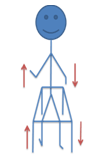 Cyclic flexion-extensions of the hand and the homolateral foot while seated (30 sec.). Cyclic flexion-extensions of the hand and the homolateral foot while seated (30 sec.). |
Is the child able to synchronize the movements? |
 Cyclic flexion-extensions of the hand and the ipsilateral foot while seated (30 sec.). Cyclic flexion-extensions of the hand and the ipsilateral foot while seated (30 sec.). |
Same. |
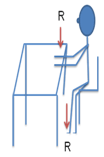 Tapping finger and foot on same side synchronized manner (30 sec.). Tapping finger and foot on same side synchronized manner (30 sec.). |
Does the child synchronize the movements? |
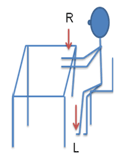 Tapping alternately finger/foot of one side with the other side (30 sec.). Tapping alternately finger/foot of one side with the other side (30 sec.). |
Is the child able to maintain the rhythm of alternate limbs? |
 Marching to a beat while clapping hands (20 sec.). Marching to a beat while clapping hands (20 sec.). |
Does the child keep rhythm? |
Alternately tapping feet and drawing circles with both fingers (30 sec.). 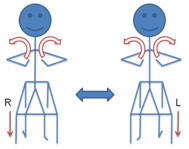 |
Is the child able to maintain the rhythm? Is the drawing recognizable? |
Jumping in place with leg and arm on the same side synchronized—starting with the preferred leg and arm forward and with the other leg and arm extended back jumps in place again reversing the positions of the arms and legs ( the action reverses back and forth) (20 sec.). 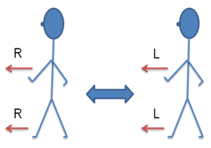 |
Does the child maintain rhythm in a synchronized manner? |
Jumping in place leg and arm on opposite side synchronized—jumps in place starting with right leg and the opposite arm forward and the other arm and leg extended back (20 sec.). 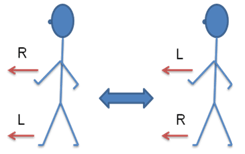 |
Is the child able to keep the movements synchronized and in rhythm? |
 Jumping up while clapping hands (20 sec.). Jumping up while clapping hands (20 sec.). |
Can the child clap hands before both feet are on the floor? Are the transitions between hand and feet smooth? |
 Jumping up while touching heels with hands (20 sec.). Jumping up while touching heels with hands (20 sec.). |
Is the child able to touch heels with hands before landing? Does the child jump with both feet at the same time and coordinate movements? |
Most fundamental gross-motor skills require some level of interlimb coordination. As mentioned earlier, what distinguishes interlimb from general gross-motor actions is the degree of synchrony and rhythmicity (timing) of movements.
Suggestions for Classroom Practice
No specific credentials exist for conducting “in-depth” evaluation of children’s interlimb coordination. Any practitioner who is aware of what interlimb coordination entails may be able to generally assess children’s performance during activities that involve interlimb coordination; observing individual children who are engaged in the activities can help detect those who appear to be having motor difficulties. A teacher who notes that a child is having constant and repeated motor problems should refer the child to a specialist.
The following activities involving interlimb coordination incorporate a relatively high level of synchronization and timing of the limbs. These activities are appropriate for inclusion with the general movement program in an early childhood program and may also be used for intervention with children displaying coordination problems.
Interlimb (Gross-Motor) Coordination Activities
Many of these activities can be performed with music played at a variety of rhythmic beats.
Bimanual
- Tapping fingers, hands, or sticks to various rhythmic beats, or in synchrony
- Doing side rotational circles with arms straight at shoulder height
- “Shadow boxing”—rotating one arm around the other, keeping arms bent at around 90 degrees, in front of the chest or above the head
- Picking up a penny with each hand and placing into boxes
- Playing the piano, electronic keyboard, or percussion instruments with both hands
- Performing finger plays such as “Itsy Bitsy Spider,” “Where Is Thumbkin,” “Tiny Tim”; playing with puppets; or playing clapping games such “Miss Mary Mack,” “Double-Double,” and “Say Say Oh Playmate.”
Coordination of Hands/Feet
- Walking and clapping hands to various rhythm beats
- Jumping and clapping hands to a rhythm or in synchrony
- Walking, jumping, running, or skipping while “shadow boxing”
- Skipping to music, combining different feet combinations while clapping hands
- Performing “jumping jacks” (watch for coordination of upper and lower limbs)
- Imitating animals that walk sideways, such as doing a "crab walk" (Older children can try sliding sideways while throwing and catching a ball.)
- Leaping in time to an accented beat of music, alternating left and right foot lead and swinging both arms
- Making locomotor movements synchronized with various rhythm beats (A number of games in which children use such movements as galloping, hopping, or skipping—such as “Hopscotch,” “Sharks and Minnows,” or “Colors”—involve interlimb coordination.)
Teachers who work with young children will find that many activities and games can be modified to incorporate additional interlimb coordination tasks. For example, if a game involves running, the practitioner could suggest to children that they try sliding sideways instead.
Conclusion
In summary, we have found that although early childhood educators may be familiar with the gross-motor skill category, the subcategory of interlimb coordination also needs greater attention than it typically receives from teachers of young children. Motor activities in this category demand a high level of rhythmicity and synchrony between the hands and feet. Research suggests that interlimb coordination has a link with skills ranging from daily life skills to complex movement behaviors and academic performance. Some children have problems with interlimb coordination. The activities described here can help the early childhood specialist to identify children with coordination problems as well as design a movement program that addresses the development of interlimb (gross-motor) coordination for all children. In fact, we believe that a regularly implemented comprehensive movement program can be instrumental in preventing problems with interlimb coordination. For more information on activity-based intervention, educators and interventionists may refer to Bricker’s (2002) volume on the Assessment, Evaluation, and Programming System (AEPS) for infants and children.
We strongly suggest that all teachers of young children make activities that emphasize interlimb coordination part of their comprehensive movement programs for the children that include other motor skill categories and general physical fitness.
References
Astill, Sarah. (2007). Can children with developmental coordination disorders adapt to tasks constraints when catching two-handed? Disability and Rehabilitation, 29(1), 57-67.
Bobbio, Tatiana G.; Gabbard, Carl; Gonçalves, Vanda M. G.; Barros Filho, A. A.; & Morcillo, A. M. (in press). The relationship between motor function and cognitive performance in Brazilian first-graders. Revista de Neurología [Journal of Neurology].
Brakke, Karen; Fragaszy, Dorothy M.; Simpson, Kathy; Hoy, Erica; & Cummins-Sebree, Sarah. (2007). The production of bimanual percussion in 12- to 24-month-old children. Infant Behavior and Development, 30(1), 2-15.
Bricker, Diane (Ed.). (2002). AEPS: Assessment, evaluation, and programming system for infants and children: Vol. 2. Test: Birth to three years and three to six years (2nd ed.). Baltimore, MD: Brookes.
Bumin, Gonca, & Kavak, Sermin Tukel. (2008). An investigation of the factors affecting handwriting performance in children with hemiplegic cerebral palsy. Disability and Rehabilitation, 30(18), 1374-1385.
Burns, Yvonne; O’Callaghan, Michael; McDonell, Brian; & Rogers, Yvonne. (2004). Movement and motor development in ELBW at 1 year is related to cognitive and motor abilities at 4 years. Early Human Development, 80(1), 19-29.
Campos, Joseph J.; Anderson, David I.; Barbu-Roth, Marianne E.; Hubbard, Edward M.; Hertenstein, Matthew J.; & Witherington, David. (2000). Travel broadens the mind. Infancy, 1(2), 149-219.
Cardoso de Oliveira, Simone. (2002). The neuronal basis of bimanual coordination: Recent neurophysiological evidence and functional models. Acta Psychologica, 110(2-3), 139-159.
Cavallari, Paolo; Cerri, Gabriella; & Baldissera, Fausto. (2001). Coordination of coupled hand and foot movements during childhood. Experimental Brain Research, 141(3), 398-409.
Diamond, Adele. (2000). Close interrelation of motor development and cognitive development and of the cerebellum and prefrontal cortex. Child Development, 71(1), 44-56.
Fagard, Jacqueline; Hardy-Léger, Isabelle; Kervella, Claude; & Marks, Anne. (2001). Changes in interhemispheric transfer rate and the development of bimanual coordination during childhood. Journal of Experimental Child Psychology, 80(1), 1-22.
Gabbard, Carl P. (2008). Lifelong motor development (5th ed). San Francisco: Pearson.
Getchell, Nancy. (2006). Age and tasks-related differences in timing stability, consistency, and natural frequency of children’s rhythmic, motor coordination. Developmental Psychobiology, 48(8), 675-685.
Getchell, Nancy, & Whitall, Jill. (2003). How do children coordinate simultaneous upper and lower extremity tasks? The development of dual motor task coordination. Journal Experimental Child Psychology, 85(2), 120-140.
Gibbs, John; Appleton, Jeanette; & Appleton, Richard. (2007). Dyspraxia or developmental coordination disorder? Unravelling the enigma. Archives of Disease in Childhood, 92(6), 534-539.
Goyen, Traci-Anne, & Lui, Kei. (2002). Longitudinal motor development of “apparently normal” high-risk infants at 18 months, 3 and 5 years. Early Human Development, 70(1), 103-115.
Jasmin, Emmanuelle; Couture, Mélanie; McKinley, Patricia; Reid, Greg; Fombonne, Eric; & Gisel, Erika. (2009). Sensori-motor and daily living skills of preschool children with autism spectrum disorders. Journal of Autism and Developmental Disorders, 39(2), 231-241.
Kennerley, Steven W.; Diedrichsen, Jörn; Hazeltine, Eliot; Semjen, Andras; & Ivry, Richard B. (2002). Callosotomy patients exhibit temporal uncoupling during continuous bimanual movements. Nature Neuroscience, 5(4), 376-381.
Mackenzie, Sam J.; Getchell, Nancy; Deutsch, Katherine; Wilms-Floet, Annemiek; Clark, Jane E.; & Whitall, Jill. (2008). Multi-limb coordination and rhythmic variability under varying sensory availability conditions in children with DCD. Human Movement Science, 27(2), 256-269.
Muetzel, Ryan L.; Collins, Paul F.; Mueller, Bryon A.; Schiessel, Ann M; Lim, Kelvin O.; & Luciana, Monica. (2008). The development of corpus callosum microstructure and associations with bimanual task performance in healthy adolescents. Neuroimage, 39(4), 1918-1925.
Murray, G. K., Veijola, J., Moilanen, K., Miettunen, J., Glahn, D. C., Cannon, T. D., Jones, P. B., & Isohani, M. (2006). Infant motor development is associated with adult cognitive categorisation in a longitudinal birth cohort study. Journal of Child Psychology and Psychiatry, 47(1), 25-29.
Otte, E., & van Mier, H. I. (2006). Bimanual interference in children performing a dual motor task. Human Movement Science, 25(4-5), 678-693.
Pellegrini, A. M., Andrade, E. C., & Teixeira, L. A. (2004). Attending to the non-preferred bimanual coordination in children. Human Movement Science, 23(3-4), 447-460.
Piek, Jan P.; Dawson, Lisa; Smith, Leigh M.; & Gasson, Natalie. (2008). The role of early fine and gross motor development on later motor and cognitive ability. Human Development Science, 27(5), 668-681.
Robertson, Steven S.; Bacher, Leigh F.; & Huntington, Noelle Lalley. (2001). The integration of body movement and attention in young infants. Psychological Science, 12(6), 523-526.
Swinnen, S. P., & Carson, R. G. (2002). The control in learning of patterns of interlimb coordination: Past and present issues in normal and disordered control. Acta Psychologica, 110(2-3), 129-137.
Wijnroks, Lex, & van Veldhoven, Nicolette. (2003). Individual differences in postural control and cognitive development in preterm infants. Infant Behavior and Development, 26(1), 14-26.
Wilson, Peter H., & McKenzie, Beryl E. (1998). Information processing deficits associated with developmental coordination disorder: A meta-analysis of research findings. Journal of Child Psychology and Psychiatry, 39(6), 829-884.
Wuang, Y.-P., Wang, C.-C.; Huang, M.-H.; & Su, C.-Y. (2008). Profiles and cognitive predictors of motor functions among early school-age children with mild intellectual disabilities. Journal of Intellectual Disability Research, 52(12), 1048-1060.
Author Information
Carl Gabbard is a professor and director of Motor Development Studies at Texas A&M University and a fellow in the American Academy of Kinesiology and Physical Education. He is also the author of Lifelong Motor Development (5th ed., Benjamin Cummings, 2008).
Carl Gabbard, Ed.D.Texas A&M University
Department of Health and Kinesiology
TAMU 4243
College Station, TX 77843-4243
Telephone: 979-845-1277
Email: c-gabbard@tamu.edu
Internet: http://motordevelopment.tamu.edu/
Tatiana Bobbio is a pediatric physical therapist in São Paulo, Brazil. She is also a doctoral student in the Department of Child and Adolescent Health at the State University of Campinas (Brazil).
Priscila Caçola is a doctoral student in the Motor Neuroscience Program and a research assistant affiliated with the Motor Development Laboratory at Texas A&M University.

